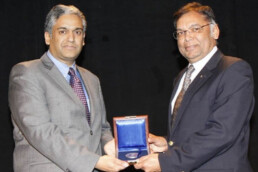MIT researchers build Quad HD TV chip
It took only a few years for high-definition televisions to make the transition from high-priced novelty to ubiquitous commodity — and they now seem to be heading for obsolescence just as quickly. At the Consumer Electronics Show (CES) in January, several manufacturers debuted new ultrahigh-definition, or UHD, models (also known as 4K or Quad HD) with four times the resolution of today’s HD TVs.
In addition to screens with four times the pixels, however, UHD also requires a new video-coding standard, known as high-efficiency video coding, or HEVC. Also at CES, Broadcom announced the first commercial HEVC chip, which it said will go into volume production in mid-2014.
Chandrakasan honored at ISSCC’s 60th Plenary Session
Anantha P. Chandrakasan earns prestigious award for outstanding contributions to his field.
Anantha P. Chandrakasan, the Joseph F. and Nancy P. Keithley Professor of Electrical Engineering at MIT, was honored with a prestigious award at the 60th annual IEEE International Solid-State Circuits Conference (ISSCC), held in San Francisco from Feb. 17-21.
In presenting Chandrakasan with the 2013 IEEE Donald O. Pederson Award in Solid-State Circuits, the IEEE recognized Chandrakasan for his outstanding contributions to the field of semiconductor circuits in terms of benefitting society, enhancing technology and demonstrating professional leadership. Chandrakasan, who also heads up MIT’s Department of Electrical Engineering and Computer Science, has been conference chair of ISSCC since 2010.
Picture-perfect
Quick, efficient chip cleans up common flaws in amateur photographs.
Your smartphone snapshots could be instantly converted into professional-looking photographs with just the touch of a button, thanks to a processor chip developed at MIT.
The chip, built by a team at MIT’s Microsystems Technology Laboratory, can perform tasks such as creating more realistic or enhanced lighting in a shot without destroying the scene’s ambience, in just a fraction of a second. The technology could be integrated with any smartphone, tablet computer or digital camera.
Existing computational photography systems tend to be software applications that are installed onto cameras and smartphones. However, such systems consume substantial power, take a considerable amount of time to run, and require a fair amount of knowledge on the part of the user, says the paper’s lead author, Rahul Rithe, a graduate student in MIT’s Department of Electrical Engineering and Computer Science.


